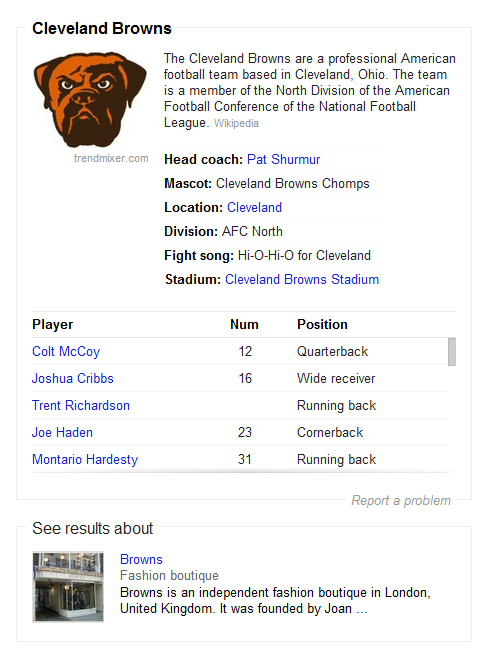In mid-May, Google added functionality that helps web searchers more easily find the information they’re seeking right from the search engine results pages (SERPs). You may be thinking that Google is already pretty good at understanding the intent of web searches and already provides helpful tools like related searches and Instant – why else would they have over 65% market share? – but this new update, powered by the Google Knowledge Graph, is a major, major change in how search engines serve their users. Understandably, the impact for web users, Google, and web marketers is huge.
What Knowledge Graph Means for Web Searchers
Knowledge Graph, in its visual form, appears as a “knowledge panel” on the right-hand column of the SERP. Do a search for [Browns] and you’ll see a perfect example of it. Without having to click into a single site, users can find information about the Cleveland Browns football team, including the head coach, players, division, and more. Some content is even linked so other related searches are only a click away.
But that’s not all. Language is ambiguous. There are many ways to say the same thing, and there are many things that have the same name. So, despite Google’s best efforts, there are simply cases in which their algorithm cannot return relevant search results. Take a look again at the [Browns] search result example. What if you were interested in finding information about Browns fashion boutique in London? The Knowledge Graph enables users to not only more quickly find information about topics of interest to them, but in cases where language ambiguity makes it impossible for Google to be 100% certain about search intent, users now have the ability to modify results with the click of a mouse.
So, what does this all mean for users? In short, it means even faster access to the information that is most relevant to searchers’ intent.

What Knowledge Graph Means for Google
Google is continually pushing the envelope on the web marketing industry. Why? Because they want their tools and services to be highly useful and valuable for web searchers. And why is that? Because the more we use Google to navigate the web, the more opportunity we will have to click on a PPC ad that generates even more revenue for Google.
It’s not clear how PPC ads will appear on SERPs that include the “knowledge panels” (I haven’t seen any yet) but don’t be surprised if that starts happening soon. The panels are in a prominent location, and Google has already confirmed an increase in searches since the Knowledge Graph rollout.
What Knowledge Graph Means for Web Marketing
The Knowledge Graph, like Panda and Penguin, are ultimately aimed at improving the searcher’s experience. Gone are the days of gaming the system with things like keyword-rich anchor text and overdone keyword density. To survive in today’s web marketing landscape, you need to focus on user intent.
Here are some things to consider in order to survive in today’s Knowledge Graph world:
- Determine your value proposition – what will the visitor get out of visiting your site? Is it clearly defined? Why should someone do business with you or visit your site instead of your competition?
- Optimize for conversions – Google analyzes metrics like bounce rate and conversion rate when deciding where to rank a site. Why? Because they’re indicators of the quality of the page. Make sure you make it clear to users how they can convert.
- Review your keywords – there are 3 types of searches: informational, transactional, and navigational. Have you considered what types of searches lead to the best visits?
- Review your keywords (some more) – Knowledge Graph reinforces the idea of language ambiguity. There are many ways to say the same thing, so find out if you’re missing any high-value keywords. Use Google’s Keyword Tool, Google Instant, Related Searches, and Webmaster Tools to find new keyword ideas. Browse competitor websites to see what types of words they’re targeting. You may find a diamond in the rough!
- Make your content user-friendly – incorporate bullet points, headers, bolding, etc. that makes it easier for people to understand the main value of a page.
- Don’t forget about PPC - Remember, Google’s a business. They want money and they get money by getting people to click on their ads. They already tell advertisers the formula to get their ads listed higher (unlike SEO), and Knowledge Graph means it’s even more likely that people will be exposed to more ads when they use Google. Don’t miss out. Start a campaign if you haven’t already.
- Don’t forget about meta descriptions - sure, they don’t do much for rankings, but if your site is ranking top 10, and you’re now fighting with Knowledge Graph AND blended results (video, images, shopping results, etc.) the least you can do is incorporate a strong call to action in the meta description. It may be subtle, but it may be just enough to encourage a few extra visits each month.
What are your thoughts about Knowledge Graph? What other considerations have you made or are you considering as a result of this change? Leave your comment below!

